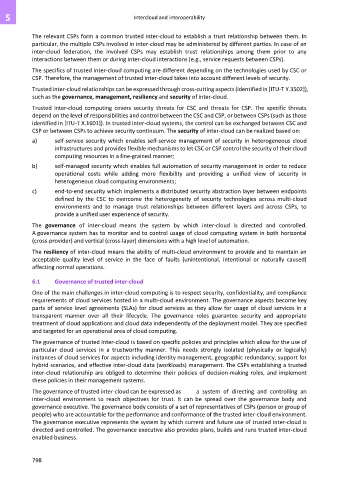Page 806 - Cloud computing: From paradigm to operation
P. 806
5 Intercloud and interoperability
The relevant CSPs form a common trusted inter-cloud to establish a trust relationship between them. In
particular, the multiple CSPs involved in inter-cloud may be administered by different parties. In case of an
inter-cloud federation, the involved CSPs may establish trust relationships among them prior to any
interactions between them or during inter-cloud interactions (e.g., service requests between CSPs).
The specifics of trusted inter-cloud computing are different depending on the technologies used by CSC or
CSP. Therefore, the management of trusted inter-cloud takes into account different levels of security.
Trusted inter-cloud relationships can be expressed through cross-cutting aspects (identified in [ITU-T Y.3502]),
such as the governance, management, resiliency and security of inter-cloud.
Trusted inter-cloud computing covers security threats for CSC and threats for CSP. The specific threats
depend on the level of responsibilities and control between the CSC and CSP, or between CSPs (such as those
identified in [ITU-T X.1601]). In trusted inter-cloud systems, the control can be exchanged between CSC and
CSP or between CSPs to achieve security continuum. The security of inter-cloud can be realized based on:
a) self-service security which enables self-service management of security in heterogeneous cloud
infrastructures and provides flexible mechanisms to let CSC or CSP control the security of their cloud
computing resources in a fine-grained manner;
b) self-managed security which enables full automation of security management in order to reduce
operational costs while adding more flexibility and providing a unified view of security in
heterogeneous cloud computing environments;
c) end-to-end security which implements a distributed security abstraction layer between endpoints
defined by the CSC to overcome the heterogeneity of security technologies across multi-cloud
environments and to manage trust relationships between different layers and across CSPs, to
provide a unified user experience of security.
The governance of inter-cloud means the system by which inter-cloud is directed and controlled.
A governance system has to monitor and to control usage of cloud computing system in both horizontal
(cross-provider) and vertical (cross-layer) dimensions with a high level of automation.
The resiliency of inter-cloud means the ability of multi-cloud environment to provide and to maintain an
acceptable quality level of service in the face of faults (unintentional, intentional or naturally caused)
affecting normal operations.
6.1 Governance of trusted inter-cloud
One of the main challenges in inter-cloud computing is to respect security, confidentiality, and compliance
requirements of cloud services hosted in a multi-cloud environment. The governance aspects become key
parts of service level agreements (SLAs) for cloud services as they allow for usage of cloud services in a
transparent manner over all their lifecycle. The governance roles guarantee security and appropriate
treatment of cloud applications and cloud data independently of the deployment model. They are specified
and targeted for an operational area of cloud computing.
The governance of trusted inter-cloud is based on specific policies and principles which allow for the use of
particular cloud services in a trustworthy manner. This needs strongly isolated (physically or logically)
instances of cloud services for aspects including identity management, geographic redundancy, support for
hybrid scenarios, and effective inter-cloud data (workloads) management. The CSPs establishing a trusted
inter-cloud relationship are obliged to determine their policies of decision-making roles, and implement
these policies in their management systems.
The governance of trusted inter-cloud can be expressed as a system of directing and controlling an
inter-cloud environment to reach objectives for trust. It can be spread over the governance body and
governance executive. The governance body consists of a set of representatives of CSPs (person or group of
people) who are accountable for the performance and conformance of the trusted inter-cloud environment.
The governance executive represents the system by which current and future use of trusted inter-cloud is
directed and controlled. The governance executive also provides plans, builds and runs trusted inter-cloud
enabled business.
798

